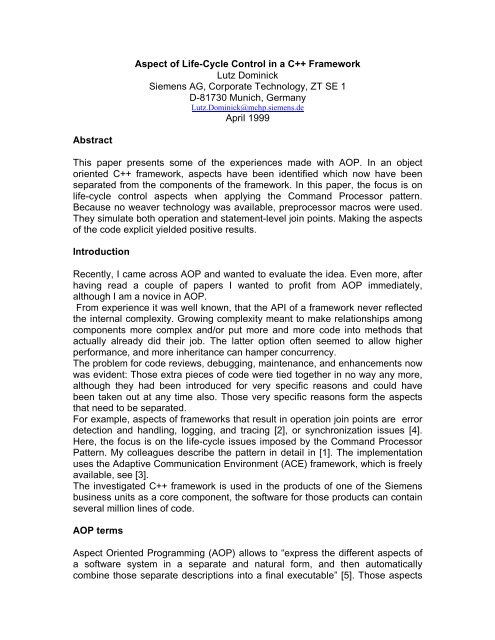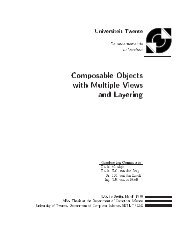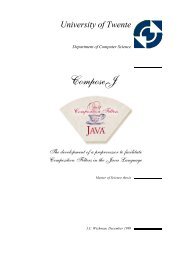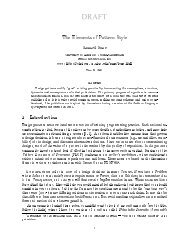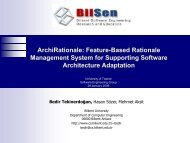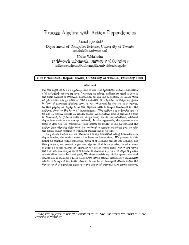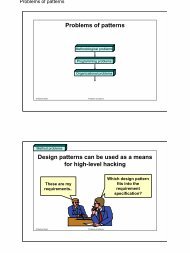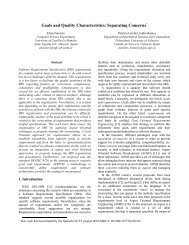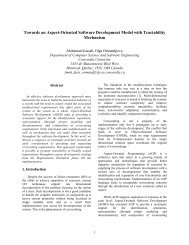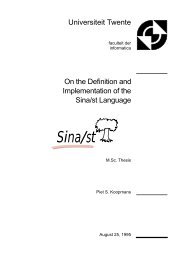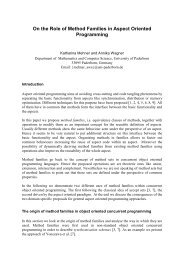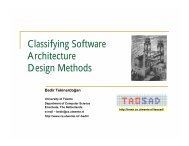Aspect of Life-Cycle Control in a C++ Framework Lutz Dominick - trese
Aspect of Life-Cycle Control in a C++ Framework Lutz Dominick - trese
Aspect of Life-Cycle Control in a C++ Framework Lutz Dominick - trese
You also want an ePaper? Increase the reach of your titles
YUMPU automatically turns print PDFs into web optimized ePapers that Google loves.
Abstract<br />
<strong>Aspect</strong> <strong>of</strong> <strong>Life</strong>-<strong>Cycle</strong> <strong>Control</strong> <strong>in</strong> a <strong>C++</strong> <strong>Framework</strong><br />
<strong>Lutz</strong> Dom<strong>in</strong>ick<br />
Siemens AG, Corporate Technology, ZT SE 1<br />
D-81730 Munich, Germany<br />
<strong>Lutz</strong>.Dom<strong>in</strong>ick@mchp.siemens.de<br />
April 1999<br />
This paper presents some <strong>of</strong> the experiences made with AOP. In an object<br />
oriented <strong>C++</strong> framework, aspects have been identified which now have been<br />
separated from the components <strong>of</strong> the framework. In this paper, the focus is on<br />
life-cycle control aspects when apply<strong>in</strong>g the Command Processor pattern.<br />
Because no weaver technology was available, preprocessor macros were used.<br />
They simulate both operation and statement-level jo<strong>in</strong> po<strong>in</strong>ts. Mak<strong>in</strong>g the aspects<br />
<strong>of</strong> the code explicit yielded positive results.<br />
Introduction<br />
Recently, I came across AOP and wanted to evaluate the idea. Even more, after<br />
hav<strong>in</strong>g read a couple <strong>of</strong> papers I wanted to pr<strong>of</strong>it from AOP immediately,<br />
although I am a novice <strong>in</strong> AOP.<br />
From experience it was well known, that the API <strong>of</strong> a framework never reflected<br />
the <strong>in</strong>ternal complexity. Grow<strong>in</strong>g complexity meant to make relationships among<br />
components more complex and/or put more and more code <strong>in</strong>to methods that<br />
actually already did their job. The latter option <strong>of</strong>ten seemed to allow higher<br />
performance, and more <strong>in</strong>heritance can hamper concurrency.<br />
The problem for code reviews, debugg<strong>in</strong>g, ma<strong>in</strong>tenance, and enhancements now<br />
was evident: Those extra pieces <strong>of</strong> code were tied together <strong>in</strong> no way any more,<br />
although they had been <strong>in</strong>troduced for very specific reasons and could have<br />
been taken out at any time also. Those very specific reasons form the aspects<br />
that need to be separated.<br />
For example, aspects <strong>of</strong> frameworks that result <strong>in</strong> operation jo<strong>in</strong> po<strong>in</strong>ts are error<br />
detection and handl<strong>in</strong>g, logg<strong>in</strong>g, and trac<strong>in</strong>g [2], or synchronization issues [4].<br />
Here, the focus is on the life-cycle issues imposed by the Command Processor<br />
Pattern. My colleagues describe the pattern <strong>in</strong> detail <strong>in</strong> [1]. The implementation<br />
uses the Adaptive Communication Environment (ACE) framework, which is freely<br />
available, see [3].<br />
The <strong>in</strong>vestigated <strong>C++</strong> framework is used <strong>in</strong> the products <strong>of</strong> one <strong>of</strong> the Siemens<br />
bus<strong>in</strong>ess units as a core component, the s<strong>of</strong>tware for those products can conta<strong>in</strong><br />
several million l<strong>in</strong>es <strong>of</strong> code.<br />
AOP terms<br />
<strong>Aspect</strong> Oriented Programm<strong>in</strong>g (AOP) allows to “express the different aspects <strong>of</strong><br />
a s<strong>of</strong>tware system <strong>in</strong> a separate and natural form, and then automatically<br />
comb<strong>in</strong>e those separate descriptions <strong>in</strong>to a f<strong>in</strong>al executable” [5]. Those aspects
crosscut the s<strong>of</strong>tware, they are not captured as a s<strong>in</strong>gle design entity that results<br />
form decomposition, but they can be looked at as some <strong>of</strong> the properties <strong>of</strong> the<br />
s<strong>of</strong>tware.<br />
Such a property “must be implemented as a component, if it can be clearly<br />
encapsulated <strong>in</strong> a generalized procedure”, and as “an aspect, if it can not be<br />
clearly encapsulated <strong>in</strong> a generalized procedure. <strong>Aspect</strong>s tend not to be units <strong>of</strong><br />
the system’s functional decomposition but rather to be properties that affect the<br />
performance or semantics <strong>of</strong> the components <strong>in</strong> systemic ways” [6].<br />
Jo<strong>in</strong> po<strong>in</strong>ts are those places <strong>in</strong> the s<strong>of</strong>tware, where aspect code gets <strong>in</strong>serted<br />
<strong>in</strong>to a component. <strong>Aspect</strong> weavers process the component and aspect<br />
languages <strong>in</strong> order to build the complete s<strong>of</strong>tware system. They work by<br />
“generat<strong>in</strong>g a jo<strong>in</strong> po<strong>in</strong>t representation <strong>of</strong> the component program, and then<br />
execut<strong>in</strong>g (or compil<strong>in</strong>g) the aspect programs with respect to it” [6].<br />
Types <strong>of</strong> jo<strong>in</strong> po<strong>in</strong>ts describe how a cross-cutt<strong>in</strong>g concern affects code at one or<br />
more jo<strong>in</strong> po<strong>in</strong>ts. Cross-cutt<strong>in</strong>g concerns that “affect the behavior <strong>of</strong> groups <strong>of</strong><br />
operations typically require the use <strong>of</strong> operation jo<strong>in</strong> po<strong>in</strong>ts”, like error detection<br />
after open<strong>in</strong>g a file, while “statement-level jo<strong>in</strong> po<strong>in</strong>ts <strong>in</strong>dicate that they can occur<br />
<strong>in</strong> any part <strong>of</strong> code”. The latter can mean chang<strong>in</strong>g an exist<strong>in</strong>g s<strong>in</strong>gle l<strong>in</strong>e <strong>of</strong> code<br />
[2],<br />
<strong>Life</strong>-<strong>Cycle</strong> <strong>Aspect</strong>s<br />
In <strong>C++</strong>, watch<strong>in</strong>g the life-cycle <strong>of</strong> objects and components is vital. Errors result <strong>in</strong><br />
crashes or memory leaks. In multi-threaded systems, the control flow for lifecycles<br />
spans many locations that execute <strong>in</strong>dependent <strong>of</strong> each other. At the<br />
same time, there are several possibilities <strong>of</strong> memory allocation, for example:<br />
• From stack, or from the heap us<strong>in</strong>g new/delete, alloc/free<br />
• From a memory pool where the memory is bound or unbound<br />
• Allocat<strong>in</strong>g and releas<strong>in</strong>g memory can be hosted by the same thread or by<br />
different threads<br />
For objects, <strong>in</strong>stances <strong>of</strong> classes <strong>in</strong> <strong>C++</strong>, several ways <strong>of</strong> cach<strong>in</strong>g are available,<br />
for example:<br />
• Caches for one type or multiple types<br />
• Caches that are global to the process<br />
• Caches that are private to one object or a set <strong>of</strong> objects<br />
• Caches that are bound to one thread<br />
The state <strong>of</strong> an object can also require the application <strong>of</strong> rules covered <strong>in</strong><br />
aspects. For example:<br />
• A method can re-occur <strong>in</strong> a call stack due to nest<strong>in</strong>g operations. Then, state<br />
needs to be organized <strong>in</strong>dependent <strong>of</strong> the nest<strong>in</strong>g level. State needs to be<br />
“local” to each nest<strong>in</strong>g level.<br />
• An object is required to allow multiple threads to call the same or different<br />
methods simultaneously without serialization on locks. Then, state needs to<br />
be organized to appear “local” to each <strong>of</strong> the callers.<br />
Each choice from the above po<strong>in</strong>ts affects the overall system performance,<br />
memory footpr<strong>in</strong>t over time, heap fragmentation and others.
For a certa<strong>in</strong> type <strong>of</strong> object, the life-cycle control flow is designed <strong>in</strong>to the system,<br />
specify<strong>in</strong>g both the location <strong>in</strong> the code and the operation that is chosen. But<br />
performance tests, for example, might show that the choice was unacceptable.<br />
Chang<strong>in</strong>g the code by hand is dangerous <strong>in</strong> large systems. Chang<strong>in</strong>g the<br />
implementation <strong>of</strong> the adherent aspect is not. Everyth<strong>in</strong>g is modeled <strong>in</strong> one place<br />
and <strong>in</strong> a concise way.<br />
Example: Command Processor Pattern<br />
The static diagram for the Command Processor Pattern conta<strong>in</strong>s the follow<strong>in</strong>g<br />
participants:<br />
Command<br />
Processo<br />
Command<br />
<strong>Control</strong>ler<br />
Abstract<br />
Command<br />
enQeue() execute()<br />
notify()<br />
Command<br />
Object<br />
execute() API()<br />
Supplier,<br />
Model,<br />
The command controller gets notified <strong>of</strong> an <strong>in</strong>com<strong>in</strong>g command <strong>in</strong> one thread.<br />
The command then is enqueued with the command processor <strong>in</strong> that thread. The<br />
command processor has a pool <strong>of</strong> threads that dequeue commands and execute<br />
command objects which can access the application model and suppliers.<br />
For this example, the code <strong>of</strong> the classes is a sketch only:<br />
class Command<strong>Control</strong>ler {<br />
notify() { // get a command<br />
cmd = new Command( obj );<br />
::readBuffer( cmd );<br />
CommandProcessor::<strong>in</strong>stance()->enQueue( cmd );<br />
// Command Processor is a process s<strong>in</strong>gleton<br />
}<br />
open() {<br />
obj = new CommandObject;<br />
}<br />
close() {<br />
delete obj;<br />
}<br />
};<br />
class CommandProcessor: public ACE_Task {<br />
enQueue( Command* cmd ) {<br />
mb = new ACE_Message_Block( cmd );<br />
putQueue( mb );<br />
}<br />
svc() { // run per thread <strong>of</strong> thread pool<br />
while( true ) {
};<br />
}<br />
mb = getQueue() )<br />
execute( mb->command );<br />
delete mb;<br />
}<br />
execute( Command* cmd ) {<br />
cmd->obj->execute( cmd ); // run Command Object<br />
delete cmd;<br />
}<br />
Each command conta<strong>in</strong>s the parameters for its execution and conta<strong>in</strong>s a<br />
reference to its command object.<br />
In the above code sketch, a couple <strong>of</strong> creation and destruction aspects are<br />
covered:<br />
• The message queue <strong>in</strong> ACE always conta<strong>in</strong>s message blocks <strong>of</strong> ACE which<br />
conta<strong>in</strong> the data to be queued. The rules for the aspect are: A message block<br />
is created <strong>in</strong> enQueue() before putQueue(), and it is destroyed <strong>in</strong> svc() after<br />
the execution <strong>of</strong> the command. The design leaves both creation and<br />
destruction <strong>in</strong> the command processor, but two threads are <strong>in</strong>volved.<br />
• The controller creates a new command and fills its data from a buffer, before<br />
enQueue(), and the command is deleted after its execution <strong>in</strong> command<br />
processor execute(), which are the rules for the life-cycle aspect <strong>of</strong> a<br />
command. Here, two objects and two threads are <strong>in</strong>volved.<br />
• The controller creates and destroys the Command Object<br />
• The command processor is a s<strong>in</strong>gleton, accord<strong>in</strong>g to the s<strong>in</strong>gleton pattern [1].<br />
The command processor life-cycle is now left out. For simplicity, the above code<br />
has created all objects from the heap and destroyed them <strong>in</strong> the same way. But<br />
the scenario allows for or even requires some enhancements, for example:<br />
• Message Blocks could be kept <strong>in</strong> a global message block pool that is<br />
accessed by all threads or the process. This allows for re-us<strong>in</strong>g empty blocks<br />
for new commands <strong>in</strong> order to ga<strong>in</strong> higher performance.<br />
• Commands could be kept <strong>in</strong> a small pool <strong>in</strong> every command object, because<br />
their type is specific to that type <strong>of</strong> command object. Commands that are<br />
done go <strong>in</strong>to the pool.<br />
• The command object has a history mechanism that applies to some <strong>of</strong> the<br />
commands. It first stores the commands on the history stack and then keeps<br />
those <strong>in</strong> the pool that drop out <strong>of</strong> the history stack (the scenario becomes<br />
more complex if the command object decides to overtake the life-cycle <strong>of</strong> only<br />
some <strong>of</strong> the commands, <strong>in</strong>stead <strong>of</strong> copy<strong>in</strong>g commands).<br />
• All command objects need to be stored somewhere to allow safe shut-down.<br />
• Creation and destruction <strong>of</strong> a command object can be much more<br />
complicated. All command objects might announce shut-down first, then we<br />
wait for pend<strong>in</strong>g commands to be executed on each command object, and<br />
then all get destroyed.
All <strong>of</strong> the above po<strong>in</strong>ts are aspects <strong>of</strong> the command process<strong>in</strong>g system. But they<br />
go “extra” because they are only aspects <strong>of</strong> the implementation. The code should<br />
not be tangled.<br />
The mere creation and destruction aspects require statement-level changes <strong>in</strong><br />
the above code, the bold l<strong>in</strong>es form the statement-level jo<strong>in</strong> po<strong>in</strong>ts.<br />
The command history aspect and the command object shut-down aspect require<br />
additional operations, whenever a command or a command object needs to be<br />
destroyed. They form operation jo<strong>in</strong> po<strong>in</strong>ts.<br />
The aspects are def<strong>in</strong>ed as pieces <strong>of</strong> code that get woven with the program code<br />
accord<strong>in</strong>g to the aspect rules. Here, they are modeled us<strong>in</strong>g a macro style<br />
language because no specific weaver or aspect oriented language has been<br />
applied yet. The rules are only comments and the macros are <strong>in</strong>serted by hand<br />
appropriately. As for the program code, only sketches for the macros are<br />
presented that are simplified. The <strong>in</strong>tended caches are available from a class<br />
library, operations <strong>in</strong>side the caches are not modeled.<br />
//// <strong>Aspect</strong>: Command Object life-cycle<br />
// apply at end <strong>of</strong> Command<strong>Control</strong>ler::open method per command object<br />
CMD_OBJ_CREATION( type ) CmdObjCache ->set(new type);<br />
// apply at beg<strong>in</strong> <strong>of</strong> Command<strong>Control</strong>ler::close method<br />
CMD_OBJ_DESTRUCTION() CmdObjCache->clear();<br />
//// <strong>Aspect</strong>: Command life-cycle<br />
// apply before call<strong>in</strong>g CommandProcessor::enQueue()<br />
CMD_CREATION( cmd, obj ) cmd = obj->cache.alloc();<br />
// apply after command execution<br />
CMD_DESTRUCTION( cmd ) cmd->obj->cache.free( cmd );<br />
//// <strong>Aspect</strong>: Message Buffer life-cycle<br />
// apply at beg<strong>in</strong> <strong>of</strong> CommandProcessor::enQuueue method<br />
MSG_BLOCK_CREATION( mb, param ) mb = MBCache->alloc( param );<br />
// apply after call to CommandProcessor::execute method<br />
MSG_BLOCK_DESTRUCTION( mb ) MBCache->free( mb );<br />
//// <strong>Aspect</strong>: Safe shut-down <strong>of</strong> Command Objects<br />
// apply before destruction <strong>of</strong> command objects<br />
CMD_OBJ_SHUT_DOWN()<br />
for( all obj = CmdObjCache->iterate() ) obj->announceShutDown();<br />
for( all obj = CmdObjCache->iterate() ) obj->waitForPend<strong>in</strong>g();<br />
//// <strong>Aspect</strong>: History mechanism<br />
// apply at end <strong>of</strong> CommandObject::execute after a positive check that<br />
// command gets stored <strong>in</strong> history stack (sample code <strong>in</strong> comments);<br />
// uses a s<strong>in</strong>gleton <strong>in</strong> thread-specific storage as the mediator<br />
HIST_OVERTAKE_LIFE_CYCLE( cmd )<br />
//If( cmd->noHistory() ) return;<br />
TSS_State::<strong>in</strong>stance()->dontDestroy(cmd);<br />
//if( history.len() > max ) CMD_DESTRUCTION( history.get() );<br />
//history.push( cmd )<br />
// apply before command destruction<br />
HIST_CHECK_LIFE_CYCLE( cmd )<br />
if( TSS_State::<strong>in</strong>stance()->dontDestroy(cmd) ) return;
apply at beg<strong>in</strong> <strong>of</strong> CommandProcessor::execute method<br />
// this is required if nested command calls occur, the state guard<br />
// stores the TSS state on the call stack and restores it when<br />
// leav<strong>in</strong>g the method, TSS state might be more complex<br />
HIST_GUARD_TSS_STATE()<br />
TSS_Guard mon( TSS_State::<strong>in</strong>stance()->getState() );<br />
TSS_State::<strong>in</strong>stance()->doDestroy(cmd); // <strong>in</strong>its TSS state<br />
The implementation <strong>of</strong> the aspects can change <strong>in</strong>dependently <strong>of</strong> the system<br />
implementation, aspects can also be removed.<br />
The history aspect affects the control flow for the command life-cycle. The rules<br />
for the control flow are still obvious (If the command was copied, the copy got<br />
onto the history stack, but the new implementation might decrease the overall<br />
performance). The history mechanism requires additional design steps and<br />
changes <strong>in</strong> the system code, because the aspect is model<strong>in</strong>g only additional lifecycle<br />
issues and not the entire mechanism, which should also be possible..<br />
Then, remov<strong>in</strong>g the aspect meant remov<strong>in</strong>g a feature.<br />
What we got so far is woven <strong>in</strong>to the code sketches below:<br />
class Command<strong>Control</strong>ler {<br />
notify() { // get a command<br />
CMD_CREATION( cmd, obj )<br />
::readBuffer( cmd );<br />
CommandProcessor::<strong>in</strong>stance()->enQueue( cmd );<br />
// Command Processor is a process s<strong>in</strong>gleton<br />
}<br />
open() {<br />
CMD_CREATION( Pr<strong>in</strong>tService ) // just a sample<br />
}<br />
close() {<br />
CMD_OBJ_SHUT_DOWN()<br />
CMD_OBJ_DESTRUCTION()<br />
}<br />
};<br />
class CommandProcessor: public ACE_Task {<br />
enQueue( Command* cmd ) {<br />
MSG_BLOCK_CREATION( mb, cmd )<br />
putQueue( mb );<br />
}<br />
svc() { // run per thread <strong>of</strong> thread pool<br />
while( true ) {<br />
mb = getQueue() )<br />
execute( mb->command );<br />
MSG_BLOCK_DESTRUCTION( mb )<br />
}<br />
}<br />
execute( Command* cmd ) {<br />
HIST_GUARD_TSS_STATE()<br />
cmd->obj->execute( cmd ); // run Command Object<br />
HIST_CHECK_LIFE_CYCLE()<br />
CMD_DESTRUCTION( cmd )<br />
}<br />
};
class CommandObject: public AbstractCommand {<br />
execute( Command* cmd ) {<br />
// do the work<br />
If( cmd->noHistory() ) return;<br />
HIST_OVERTAKE_LIFE_CYCLE( cmd )<br />
if( history.len() > max )<br />
CMD_DESTRUCTION( history.get() );<br />
history.push( cmd )<br />
}<br />
};<br />
Conclud<strong>in</strong>g Remarks<br />
<strong>Aspect</strong>s help to organize program code where design could tangle the system<br />
code. At the same time, control is re-ga<strong>in</strong>ed over the aspect code. This allows for<br />
more flexible evolution <strong>of</strong> the s<strong>of</strong>tware, and, to my op<strong>in</strong>ion, is one <strong>of</strong> the means<br />
aga<strong>in</strong>st s<strong>of</strong>tware’s “death thru ma<strong>in</strong>tenance”. The exist<strong>in</strong>g aspects can be reused<br />
<strong>in</strong> the same or other s<strong>of</strong>tware systems.<br />
Perhaps aspects could function as the natural extension to code generation tools<br />
like wizards and case tools.<br />
The current state <strong>of</strong> work lacks the application <strong>of</strong> weaver technology. So more<br />
complex aspects cannot be handled at all. Macros cannot be treated as an<br />
equivalent to a weaver. Other issues also need to be answered, like debugg<strong>in</strong>g<br />
the complete system.<br />
References<br />
[1] Frank Buschmann, Reg<strong>in</strong>e Meunier, Hans Rohnert Peter Sommerlad,<br />
Michael Stal: A System <strong>of</strong> Patterns, Wiley and Sons Ltd, 1996<br />
[2] Hardol Ossher, Peri Tarr: Operation-Level Composition: A Case <strong>in</strong> (Jo<strong>in</strong>)<br />
Po<strong>in</strong>t, Proceed<strong>in</strong>gs <strong>of</strong> ECOOP98<br />
[3] Douglas C. Schmidt, Wash<strong>in</strong>gton University <strong>of</strong> St. Louis, home page at<br />
http://www.siesta.cs.wustl.edu/~schmidt<br />
[4] David Holmes, James Noble, John Potter: <strong>Aspect</strong>s <strong>of</strong> Synchronization,<br />
Proceed<strong>in</strong>gs <strong>of</strong> ECOOP97<br />
[5] Gregor Kiczales et al.: <strong>Aspect</strong> Oriented Programm<strong>in</strong>g: A Position paper<br />
from the Xerox PARC <strong>Aspect</strong> Oriented Programm<strong>in</strong>g Project”,<br />
Xerox PARC, 1996<br />
[6] Gregor Kiczales, John Lamp<strong>in</strong>g, Anurag Medbeker, Chris Maeda,<br />
Crist<strong>in</strong>a Lopes, Jean-Marc Lo<strong>in</strong>gtier, John Irv<strong>in</strong>g: <strong>Aspect</strong> Oriented<br />
Programm<strong>in</strong>g, ECCOP97


